Biodiversity refers to the total amount of variation found in living things. In terms of cacao, biodiversity refers to the genetic variation within the plant, the number of related species and the contribution of the species to regional diversity.
History of the term biodiversity:
Unlike many other common ecological terms, use of the word biodiversity involves a relatively short history. The term biodiversity started to appear in scientific discussion in the mid-1980s in a casual usage associated with conservation biology or as a condensed usage for biological diversity. Since that time, the use of the term has increased to an expectation that increasing biodiversity represents an overarching goal of conservation biology.
Scientists generally recognize three main levels or types of biodiversity:
- Genetic
- Species
- Ecosystem or ecological
Each of these levels may be further subdivided depending on what measure of biodiversity gets compared across any particular group.
Example of biodiversity measures include, but are not limited to, nucleotide diversity (i.e., the individual units that make up DNA), intraspecific variation (i.e. the range in variation found within a single species), species richness (the number of total species) and species evenness (the relative distribution of species compared to their abundance).
Application to chocolate
Genetic diversity of cacao generally refers to the genetic variation found in a population, often referred to as a cluster from statistical analysis.
No one really knows how many clusters [possibly also considered at the level of subspecies] exist, although the initial recognition of 10 clusters by Motamayor et al (2008) has attempted to replace the traditional reference to three subspecies (criollo, forastero and trinitario).
The cumulative variation in a population depends on the number of individual clones, also often referred to as a varietal, found within a population. Desirable clones exhibit certain traits that tend to promote cultivation and production of a cacao crop.
In addition, each individual plant also represents a reservoir of genetic diversity, collectively known as a genome. We may compare genomes between and across individuals to examine specific gene functions.

At the species level, only one species produces what we term chocolate, Theobroma cacao. Other closely related species (Jaguar cacao, Theobroma bicolor or cupuaçu, Theobroma grandiflorum) yield fruits that some makers use in their products, but there’s only one true chocolate tree.
However, cacao growers generally seek to promote species richness among their cacao trees to foster pollination, nutrient cycling and structural protection. Survival of cacao depends on other species, specifically small flies (midges) responsible for pollination, canopy trees that offer protection and shade and frugivores (fruit-eating organisms) that help disperse the seeds. However, cultivation of cacao also depends on maintaining biodiversity of the natural suite of bacteria and yeasts responsible for fermentation.
At the ecosystem level, biodiversity refers to all the habitats and species that make up the larger forest. Measures of biodiversity at the ecosystem level often include specific ecological functions such as nutrient cycling, water retention or carbon flux. Cacao may occupy different types of forest ecosystems and using the term global biodiversity refers to the total variation present in all areas in which one finds cacao.
Value of biodiversity
We value biodiversity as a whole because it provides us with a number of ecosystem services (e.g. food, shelter, erosion protection, carbon sequestration, etc…) that benefit humans economically, socially and environmentally.
In terms of biodiversity as a desirable outcome, scientists generally focus on native, or indigenous, biodiversity. Native areas harbor a reservoir of natural variation needed by the species to confront threats such as disease or water scarcity.
The terms biodiversity and conservation biology often get used interchangeably, but it is really the mission of conservation biology to preserve native biodiversity. One recent paper (Gonzàlez-Orozco et al. 2020) estimates that 95% of the suitable habitat for wild cacao in Columbia occurred in unprotected areas, providing a clear link between the two terms.
Non-native biodiversity, on the other hand, often presents an oxymoron in terms of the goals of conservation biology, while increased biodiversity generally garners a positive reaction. However, the presence of more species may not yield positive outcomes for cacao when considering the biodiversity of non-natives, insect pests or fungal pathogens. General agreement exists that cacao agroforestry boosts biodiversity in comparison to more heavily managed, monocultural agricultural practices.
The argument to protect biodiversity works both ways with chocolate. On the one hand, one strategy involves arguing for the general protection of the earth because Earth serves as the only planet [that we know of] that can provide chocolate. On the other hand, a campaign that argues for preservation of the rainforest to save chocolate helps secure the treasure of native cacao diversity that might hold the key to chocolate’s overall survival as an industry given the challenges posed by climate change.

Two examples of biodiversity connections to fine chocolate
Recognizing the appeal to certain consumers, two companies associated with fine chocolate have incorporated promoting biodiversity explicitly into their mission statements.
The Smithsonian’s National Zoo and Conservation Biology Institute in collaboration with the American Bird Conservancy recently highlighted Zorzal Cacao as a producer whose practices increase species diversity of songbirds in the Dominican Republic.
Beyond Good, formerly Madécasse, prominently features endangered Madagascar lemurs on their packaging and has worked with various scientific agencies to document biodiversity on the farms from which they harvest cacao. In 2021, the government of Madagascar even issued a stamp showing the Mongoose Lemur next to a cacao pod in celebration of World Lemur Day.

Note: The Fine Chocolate Glossary has no direct affiliations with either Zorzal Cacao or Beyond Good. The expert author of this post simply identified these two instances as leading examples of how fine chocolate helps promote preservation of biodiversity.
Próximamente versión en español
Entry added: August 1, 2023; Entry Updated: September 21, 2023
Verified on: September 23, 2023
Authored by
Romi Burks, Professor of Biology
Academic / university faculty
References
“Geographic and Genetic Population Differentiation of the Amazonian Chocolate Tree (Theobroma cacao L),” Juan C. Motamayor, Philippe Lachenaud, Jay Wallace da Silva e Mota, Rey Loor, David N. Kuhn, J. Steven Brown and Raymon J. Schnell, PLoS ONE, 2008.
“Exploring the diversity and distribution of crop wild relatives of cacao (Theobroma cacao L.) in Colombia,” Carlos E. González-Orozco, Angela A. Sánchez Galán, Pablo E. Ramos and Roxana Yockteng, Genetic Resources and Crop Evolution, June 14, 2020.
“Origin of the Term Biodiversity,” Sahotra Sarkar, BioScience, July 1, 2021.
“The Convention on Biological Diversity, Article 2. Use of Terms,” Convention on Biological Diversity, Accessed on August 28, 2023.
Have a comment on this definition?
